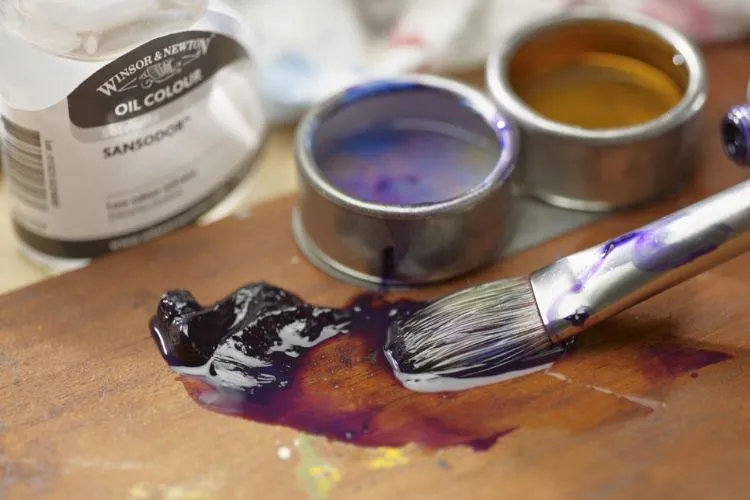Artists and environmental advocates often find themselves at a crossroads when discussing the sustainability of art materials, particularly acrylic paints.
These vibrant, versatile mediums are staples in studios worldwide, but their environmental impact prompts a significant inquiry: Is acrylic paint recyclable or Can it be responsibly recycled?
This detailed exploration seeks to unpack the complexities of recycling acrylic paint, offering insight and sustainable alternatives for conscientious creators.

Is Acrylic Paint Recyclable?
Acrylic paint, due to its chemical composition, is generally not considered recyclable through conventional municipal recycling programs.
The mixture of acrylic polymer (a type of plastic) with pigments and various additives makes it unsuitable for the recycling process designated for plastics or household waste.
Communities might offer specialized disposal methods through hazardous waste collection events to manage leftover acrylic paint responsibly. For small quantities, letting the paint dry and then scraping it off for disposal in regular trash is sometimes recommended.
However, for larger amounts, it is advisable to consult with local waste management facilities. The combination of acrylic’s plastic base with added pigments and chemicals complicates the recycling process.
Therefore, minimizing waste by only preparing the required amount of paint for use is recommended as a more sustainable practice.
Disposal Methods for Acrylic Paint
Proper disposal of acrylic paint is crucial due to its chemical composition, which can be harmful to the environment if not handled correctly. Unlike watercolor or oil paints, acrylics are a plastic polymer, and once dried, they are more difficult to break down.

Whether you are an artist, a DIY enthusiast, or simply looking to clean out old art supplies, it’s important to understand how to dispose of or recycle acrylic paint responsibly.
Drying Out Acrylic Paint
- Small Amounts: For tubes with a little paint left, squeeze the paint onto a piece of scrap cardboard or paper and let it dry out. Once completely dry, it’s typically safe to dispose of it with your regular trash. This method minimizes the environmental impact as the dried paint will not leach into the ground.
- Large Amounts: For cans or large quantities of paint, consider using cat litter, sand, or a commercial paint hardener. These materials absorb the liquid component, allowing the paint to solidify more quickly. Once solidified, it can be disposed of as solid waste.
Using Paint Disposal Facilities
Many communities offer hazardous waste collection services or facilities that accept acrylic paint. These facilities have the means to dispose of or recycle paint in a way that minimally impacts the environment.
- Local Resources: Check with your local waste management authority or environmental protection agency for guidelines and services. Some areas hold specific collection days for hazardous materials.
Recycling Programs
While acrylic paint itself is challenging to recycle once it’s dried, there are programs that can repurpose liquid paint for community projects or as a base for recycled paint products.
- PaintCare: In the U.S., PaintCare offers drop-off locations in some states for paint recycling. They accept various paint products, including acrylic paints, and repurpose them responsibly.
Donation
If your acrylic paint is still viable, consider donating it to schools, community centers, or non-profit organizations that can use it for art projects. This method ensures the paint is used to its fullest extent, reducing waste.
Creative Reuse
Before deciding to dispose of your paint, think about any personal projects that could use the remaining paint.
Acrylics are versatile and can be used on a variety of surfaces, from canvas to wood. Using up the paint not only extends its life but also prevents unnecessary waste.
Important Considerations
- Never Pour Down Drains: Disposing of acrylic paint in sinks can harm water systems and is not an environmentally friendly option.
- Follow Local Guidelines: Always adhere to your local waste disposal regulations to ensure that you’re disposing of paints in a legal and environmentally safe manner.
By choosing responsible disposal or recycling methods for acrylic paint, we can significantly reduce the environmental impact and ensure a safer ecosystem for future generations.
Innovation and Sustainability in Paint Usage
The intersection of art and environmental responsibility is spurring innovation within the industry. The market now sees a burgeoning selection of eco-friendly paints designed to minimize ecological harm while maintaining the quality artists expect.

These advancements reflect a broader push towards sustainability in the art world, requiring collective engagement from artists, manufacturers, and consumers.
Key Points for Artists and Hobbyists
Achieving sustainability in artistic practice is a feasible goal, attainable through thoughtful application and community engagement.
Leveraging leftover paints in creative projects, adhering to proper paint storage methods, and participating in paint exchange programs not only foster sustainability but also build community among artists.
These strategies reduce not only waste but also the art community’s collective environmental footprint.
Frequently Asked Questions (FAQs)
Why is acrylic paint considered hazardous waste?
The chemical composition of acrylic paint, particularly in large quantities, can pose environmental hazards. Improper disposal risks water and soil contamination.
Can acrylic paint containers be recycled?
Yes, but with caveats. Empty, thoroughly cleaned paint containers may be recyclable, contingent upon local recycling regulations.
How can I minimize my environmental impact while using acrylic paints?
Minimizing paint waste, opting for eco-friendly paint alternatives, and adhering to proper disposal guidelines are key strategies for reducing environmental impact.
Are there recyclable alternatives to traditional acrylic paints?
Yes. The market for sustainable art materials is expanding, offering alternatives designed to lessen environmental harm. Thorough research can help in finding these eco-friendly products.
How should I handle unused acrylic paint?
Unused acrylic paint can find new life through donation to educational programs, community centers, or art collectives. Otherwise, participating in hazardous waste collection events is a responsible disposal method.
Conclusion:
While the quest to recycle acrylic paint faces significant challenges, the journey towards sustainability in art practices offers numerous paths forward.
Through conscientious consumption, proper disposal, and the embrace of eco-friendly alternatives, the art community can significantly reduce its environmental impact.
As we embrace innovation and foster collective responsibility, art and sustainability can coexist harmoniously, paving the way for a greener, more sustainable future in the artistic realm.

Meet Isabella Anderson, your acrylic painting mentor with over a decade of brush-wielding mastery. Dive into the colorful world of acrylics with her expert guidance, featured exclusively on ‘Acrylic Authority.’ Unleash your inner artist and explore the limitless possibilities of this versatile medium alongside a true acrylic aficionado.
